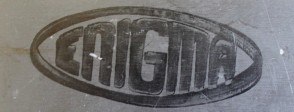Show students images of the Enigma machine and, without revealing any information, invite students to make observations. Identify the machine’s working parts and discuss students’ ideas about what the machine was for and how it could have been operated.
Use videos in For the classroom to show students how the Engima machine worked. Discuss the fact that it was battery powered; can students identify why this made it useful to the German armed forces? Portability was essential; this is why Enigma did not transmit as well as encoding messages; with the addition of transmission technology it would not have been portable. Ask students to consider the different jobs involved in creating, encoding and transmitting a message – they could act this out with a very brief role play.
Explain to students that this particular Enigma machine is at Bletchley Park, which was the base for the British Government Code and Cipher School during World War II. Why do students think Britain wanted to break Enigma? What kind of expertise was needed to break it? What intelligence would the British need to gather to help to crack it? Discuss why Bletchley park has enigma machines such as this one, and how the British used Enigma machines. Tell the story of the cracking of the Enigma code using a selection of the resources in For the classroom.
Give students cards labelled with different jobs related to the use of the Enigma machine on both sides; for example: German Enigma machine operator (encoding), German radio operator (transmitting); German radio operator (receiving); German Enigma machine operator (decoding), German operations commander, British listening station operator, British dispatch riders, British bombe operator, British enigma machine operator, British transcriber, British translator, British intelligence agent, add British naval high command, British anti-sub destroyer captain. Discuss each role and get students up and moving around the room with their labels to create a web or flow diagram demonstrating how Enigma machines were used. It may also be useful for students to draw a diagram or write an explanation.
Ask students to examine the network or flow diagram they have created and consider how security could be maintained on the British side, discussing how much each person needs to know in order to complete their task, and what needed to be kept secret from them in order to maintain security.
Use resources in For the classroom to examine Alan Turing’s work at Bletchley Park and trace the subsequent events of his life, his conviction in 1952 and his death in 1954. In 2013 Turing was officially pardoned for the offence of indecency for which he was convicted in 1952. This was motivated partly by appreciation of Turing’s work during the war, which had remained secret until 1975. The BBC news article in For the classroom provides a starting point for a discussion about Turing’s pardon, and about the impact of historical events in current affairs.
What impact did Bletchley Park and Ultra have on German and British lives?
By re- focusing away from the large scale of military operations, students can gain an understanding of how intelligence operations affected individuals. Students could investigate the lives of workers at Bletchley Park starting with the web resource on the women of Bletchley Park and the interview with a woman code breaker: what do the women say and what impression do students get of their lives and how they felt about their work? If it is true that Ultra shortened the war, who benefited from this and how? Resources in A bigger picture and the Imperial War Museum links in For the classroom will help students to examine the contribution of Ultra intelligence and occasions when Ultra was of little use.
How did the Bletchley Park code breakers shape our modern world?
The Science Museum’s Codebreaker video in For the classroom would provide a starting point for examining the legacy of Turing and other Bletchley Park mathematicians who were pioneers of early computing. As well as looking at the developments in the technology itself, student would identify the impact on a range of aspects of life from the social to healthcare, communications and issues of privacy and security. This could be synthesised into a presentation based on selecting most significant milestones in the history of digital technologies and society.


